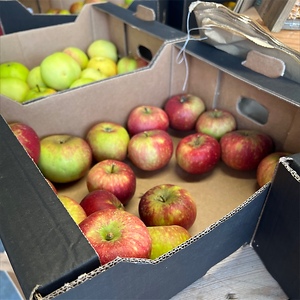


Ingrid Marie Apples
Estimated Inventory, 1 Lb : 0
Description/Taste
Ingrid Marie apples are a small to medium-sized varietal, averaging 6 to 7 centimeters in diameter, and have a conical to oblate, slightly flattened shape with moderately thick, woody brown stems. The apple’s skin is smooth and semi-thick with a matte appearance, and there is some light grey-brown russet surrounding the stem. The skin also bears a golden yellow to yellow-green base hue, flushed with large patches, streaks, and striations of crimson to dark red blush. When mature, the apples are covered in tan lenticels, and the blush can sometimes showcase a blue-red overtone, giving the apple a variegated look. Ingrid Marie apples have a crisp, soft, aqueous, and fine-grained cream-colored flesh, encasing a sizeable central core filled with dark brown, oval, and pointed seeds. The flesh also releases a honeyed, fruity fragrance and contains a delicate blend of sweet and tangy flavors mixed with a subtle tartness reminiscent of the cox orange pippin apple.
Seasons/Availability
Ingrid Marie apples are available in the mid-fall through winter.
Current Facts
Ingrid Marie apples, botanically classified as Malus domestica, are a late-season cultivar belonging to the Rosaceae family. The delicately sweet apples grow on trees that can reach 3 to 5 meters in height and are a productive variety favored for their soft, fine-grained flesh and light, balanced flavor. Ingrid Marie apples are a dessert variety generally grown in home gardens. The cultivar was well-known in the 1930s, planted in home gardens and select commercial orchards in Northern Europe and the United Kingdom. In the modern-day, it has become a rare variety, reserved for heritage and private orchards. Ingrid Marie apples are versatile and can be consumed out of hand or utilized in cooked preparations.
Nutritional Value
Ingrid Marie apples are a source of vitamin C to strengthen the immune system, potassium to balance fluid levels within the body, and fiber to regulate the digestive tract. The apples also provide some copper to develop connective tissues, vitamin K to assist in faster wound healing, manganese, vitamin B6 to maintain amino acid levels within the bloodstream, and quercetin, a naturally occurring flavonoid that contributes anti-inflammatory and antioxidant-like properties.
Applications
Ingrid Marie apples have a sweet and tangy flavor well suited for fresh eating. The apples can be eaten with or without the skin, depending on preference, and have a soft flesh that is savored when consumed straight, out of hand. Ingrid Marie apples can be sliced and displayed on cheese plates, used as a fresh topping over porridge, oatmeal, and French toast, or blended into smoothies. The apples can also be cut and layered into sandwiches, paired with spreads, dips, and soft cheeses on crostinis, or slivered and mixed into crunchy slaws with fresh herbs. In addition to raw preparations, Ingrid Marie apples can be simmered into sauces for roasted meats, baked into crumbles and crisps, cooked into a puree as a base flavor for pies, tarts, and turnovers, or used to make jams and jellies. The apples are also mashed and pressed through filters to make flavorful cider. Ingrid Marie apples pair well with nuts such as walnuts, pecans, and almonds, meats such as poultry, beef, pork, and fish, shrimp, citrus, fennel, spices including ginger, cinnamon, allspice, and star anise, and herbs such as parsley, sage, and rosemary. Whole, unwashed Ingrid Marie apples will keep for several weeks when stored in the refrigerator's crisper drawer. The apples will keep for 1 to 2 months in professional cold storage, but the variety has a better texture when consumed relatively quickly. The longer Ingrid Marie apples are held in storage; the more likely their flesh will become mealy.
Ethnic/Cultural Info
Ingrid Marie apples were named by discoverer and schoolteacher Mr. K Madsen in Denmark. Madsen named the variety after his daughter, Ingrid Marie, who died at a young age. The boutique apple cultivar is not well known outside of Denmark and its surrounding countries in Northern Europe, but in Denmark, Ingrid Marie apples are most notably cooked into old-fashioned apple cakes. The sweet dessert is comprised of applesauce, crushed cookies, and whipped cream, layered into a rich, sweet, and tangy dish. Apple cake is traditionally served as an afternoon accompaniment to tea or coffee or is layered into a crystal bowl for home dinner parties. In addition to its prominence in desserts, Ingrid Marie apples are also known as a parent apple to the famous elstar apple. Elstar is a modern variety bred in the mid 20th century and is widely sold as a commercial dessert cultivar throughout Europe.
Geography/History
Ingrid Marie apples were discovered growing as a chance seedling in an orchard on Funen, also known as Fyn, the third-largest island of Denmark. The apples were first noticed in 1910 by schoolteacher Mr. K Madsen and were deemed a new cultivar around 1920. Mr. Madsen found the apples near Hoed School, an education establishment situated near the city of Flemloese. In 2003, Swedish scientists determined that the parent varieties of Ingrid Marie consisted of cox orange pippin and guldborg apples. Over time, several sports of Ingrid Marie have become popular home garden cultivars, including Red Ingrid Marie, also known as Karin Schneider apples. Red Ingrid Marie was discovered in 1950 and is distinguished from Ingrid Marie apples by its predominately dark red coloring. There has been some confusion between Ingrid Marie and Red Ingrid Marie, as some growers and plant retailers generally label the two separate varieties as the same, under Ingrid Marie. Today Ingrid Marie apples are grown commercially on a small scale throughout Sweden, Denmark, and Northern Germany and are seasonally available through select grocers, distributors, and local farms. The apples are also found as a specialty variety in home gardens in the United Kingdom.








